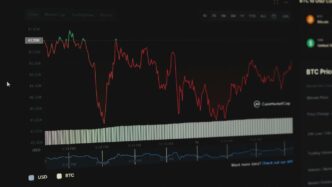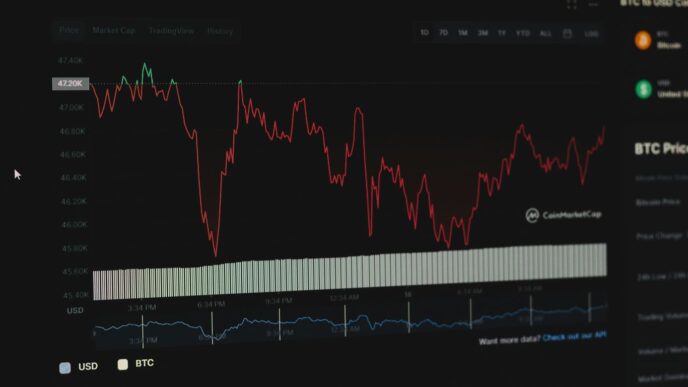Okay, so 2026 is just around the corner, and things are definitely going to get interesting. We’ve seen a lot of tech talk lately, but what’s actually going to shake things up? It feels like we’re on the edge of some pretty big changes, not just with computers, but with how we live, work, and even think. Let’s break down what will happen to Earth in 2026, beyond all the buzz.
Key Takeaways
- AI is going to start taking more jobs, and it’s going to happen fast. Companies are already letting people go because of it.
- Robots that look like people, called humanoids, will become easier to get, kind of like renting a service, and this will change how businesses operate.
- We’re going to see big steps forward in healthcare that could help people live healthier for longer, and maybe even brain-computer gadgets for everyday use.
- China is expected to pull ahead of the West in terms of new technology, and political shifts, like a potential return of Trump’s policies, could really mess with how tech companies are regulated.
- It’s going to be even harder to know what’s real online because of AI-generated content, and there will be a flood of information, making trust a big issue.
The Shifting Landscape Of Artificial Intelligence In 2026

Alright, let’s talk about AI in 2026. It feels like just yesterday we were marveling at chatbots, and now? Things are getting seriously interesting, and maybe a little unsettling. The big buzzword is ‘Augmented Intelligence,’ which basically means AI isn’t just a tool anymore; it’s becoming a partner, woven into everything we do. It’s not about machines becoming conscious, not yet anyway, but about them getting really, really good at specific tasks, way faster than we can.
AI-Powered Job Losses Reach Critical Mass
This is the one that keeps a lot of people up at night. We’re not just talking about a few jobs here and there. By 2026, AI is expected to hit a point where its impact on the job market is undeniable, affecting a much wider range of professions. Think about it: if AI can do a task faster, cheaper, and sometimes even better than a human, businesses will naturally lean that way. It’s not necessarily about AI taking over, but about how quickly it can automate tasks that were once thought to be safe.
- Automation of routine tasks: Customer service, data entry, and even some forms of content creation are prime candidates.
- Impact on creative fields: While creativity is often seen as uniquely human, AI is making inroads into areas like graphic design and basic coding.
- The need for reskilling: This shift will put a huge emphasis on people learning new skills that complement AI, rather than compete with it.
The AI-Enhanced Metaverse Reimagined
Remember the metaverse hype from a few years back? Well, AI is giving it a serious reboot. Instead of just clunky avatars in digital worlds, imagine AI creating dynamic, responsive environments and characters. These aren’t just static game worlds; they’re spaces that can adapt, learn, and interact with users in much more sophisticated ways. Think AI generating personalized experiences, managing complex virtual economies, or even acting as intelligent guides within these digital spaces. It’s about making these virtual worlds feel more alive and useful.
Shrinking Language Models And World Models
We’ve all seen how impressive Large Language Models (LLMs) are at generating text. But the next big step is moving beyond just words. Researchers are focusing on ‘World Models,’ which are essentially AI systems that try to understand the physical world and how things work, not just patterns in text. At the same time, there’s a push to make these models smaller and more efficient – ‘Shrinking Language Models.’ This means AI could run on more devices, not just massive data centers, making it more accessible and practical for everyday use. It’s a move towards AI that doesn’t just talk, but actually understands context and the real world a bit better.
Embodied Intelligence And Robotics Take Center Stage
Forget AI just living in the cloud or on your phone. In 2026, intelligence is getting a body. We’re talking about AI stepping out of the screen and into the real world, and it’s going to change a lot of things.
Humanoids-as-a-Service Become Accessible
Remember those sci-fi movies with robots doing all the chores? It’s starting to feel a bit more real. By 2026, you might actually be able to rent a humanoid robot for specific tasks. Think of it like hiring a contractor, but instead of a person, it’s a robot. Companies are starting to offer these "humanoids-as-a-service" for things like warehouse work, elder care assistance, or even just helping out at events. It’s not quite like having Rosie the Robot from The Jetsons, but it’s a big step. These robots are getting better at understanding their surroundings and performing complex actions. It’s still early days, and the cost is a factor, but the idea of having a physical AI helper is becoming a reality for more businesses.
AI-Driven Crime Spreads Globally
With more intelligence out in the world, unfortunately, that means more ways for bad actors to use it. We’re already seeing AI used for scams and misinformation, but in 2026, this is expected to get more sophisticated and widespread. Think AI-powered hacking tools that can adapt on the fly, or deepfake technology used for more than just pranks – imagine it being used to impersonate officials or create fake evidence. The challenge is that AI can automate and scale criminal activities in ways that were previously impossible. Law enforcement and cybersecurity experts are scrambling to keep up, developing AI tools of their own to detect and counter these new threats. It’s a bit of an arms race, and unfortunately, the bad guys often have a head start when it comes to exploiting new tech.
The Rise of Pervasive Hardware
AI isn’t just in robots; it’s going to be in a lot more everyday objects. We’re talking about smart devices that are more aware of their environment and can communicate with each other more effectively. This could mean anything from smarter home appliances that anticipate your needs to industrial sensors that can predict equipment failures before they happen. This widespread integration of AI into hardware means our physical world will become much more responsive and, in some ways, more predictable. However, it also raises questions about privacy and security. When everything is connected and collecting data, who is watching, and what are they doing with that information? We’ll likely see more public debate and regulation around how this pervasive hardware is used and protected.
Transformations In Healthcare And Human Augmentation
Okay, so 2026 is shaping up to be a pretty wild year for how we handle our health and, well, ourselves. Forget just going to the doctor when you’re sick; things are shifting big time towards keeping us healthy before anything goes wrong. Think of it like this: your body is becoming a constant data stream. Wearable gadgets, those little diagnostic kits you can use at home, and even sensors in your living space are all feeding information about what’s going on inside you. This means we can catch tiny changes – like your sleep getting worse or a slight inflammation – weeks before you’d actually feel sick. It’s a move from just fixing problems to actively extending the years we feel good and can do things.
AI is really speeding up how fast we can find new medicines, cutting down development times from years to just months. Regulators and hospitals are having to catch up, figuring out how to use all this real-time data to make better decisions, faster. It’s a whole new ballgame. We’re even seeing insurance companies get involved, not just paying for when you’re sick, but actually paying for you to get tests and coaching to stay healthy. It’s like they’re betting on us living longer, healthier lives, which is a pretty big deal. This is all part of a larger trend towards human augmentation, where technology is helping us do more and be more.
Here’s a quick look at what that might mean:
- Continuous Monitoring: Your body’s signals become a live feed, not just a snapshot during a doctor’s visit.
- Early Intervention: Catching potential issues way before symptoms show up.
- Personalized Therapies: Treatments tailored specifically to your body’s real-time data.
It’s not just about living longer, but living better for longer. The focus is on keeping us vital and active, rather than just treating decline. It’s a pretty exciting, if slightly overwhelming, prospect for how we’ll all experience aging and health in the coming years.
Geopolitical And Technological Power Dynamics
It feels like the whole world is rearranging itself right now, and technology is right in the middle of it. We’re not just talking about new gadgets; we’re talking about who’s leading the pack and how that changes things for everyone. It’s a bit dizzying, honestly.
China’s Technological Ascendancy Over The West
China is really pulling ahead in a lot of tech areas. Think super-efficient AI, new kinds of computer chips, and factories full of robots working together. The West just hasn’t caught up to this integrated approach yet. This isn’t just a temporary lead; it’s like the whole center of innovation is shifting. For businesses and governments, this means a big rethink is needed. Chinese tech is getting cheaper, faster, and often just plain better. So, we’ll probably see more companies working with China while also trying to build up their own capabilities elsewhere, especially in things like chips and manufacturing. It’s about not putting all your eggs in one basket.
- Mapping Supply Chains: Companies will need to get really good at knowing exactly where their parts come from and what risks are involved.
- Navigating Different Rules: Working across countries means dealing with different laws and ethical standards, which will get more complicated.
- Testing for Problems: Just like testing how well an AI works, we’ll need to rigorously test for security and political risks.
But this shift isn’t all bad news. Cheaper tech from China could actually help smaller businesses and developing countries get access to powerful tools. It’s all about how we choose to adapt and make sure everyone benefits.
The Trumpian Doctrine’s Impact On Tech Policy
If a certain political figure returns to the scene, expect some big changes in how technology is handled. We could see less regulation on AI, a boost for cryptocurrencies, and a stronger focus on national tech interests. This would be a pretty sharp turn from current approaches, creating a new environment for major tech companies to navigate. It’s a scenario that could shake up everything from innovation to international tech partnerships. The focus might shift heavily towards domestic production and protectionist policies, potentially leading to more fragmented global tech markets. This could mean:
- Deregulation: A push to remove government oversight on emerging technologies like AI.
- Tech Nationalism: Prioritizing national companies and technologies over foreign ones.
- Crypto Revival: Potentially more favorable policies for digital currencies and blockchain technology.
This kind of shift would definitely create waves, forcing a lot of companies to adjust their strategies quickly.
The Evolving Nature Of Information And Trust
So, 2026. It’s shaping up to be a wild ride, especially when it comes to what we believe and who we trust online. Remember how last year felt like a bit of a mess with all the fake stuff? Well, buckle up, because it’s only getting more intense. We’re talking about a situation where it’s getting harder and harder to tell what’s real and what’s not.
The Collapse Of Digital Trust Intensifies
It feels like digital trust took a nosedive in 2025, and 2026 is just picking up the pieces, or maybe just kicking them around. AI is getting seriously good at making things that look and sound completely real, but aren’t. Think deepfakes, but on a whole new level, and scams that are way more convincing than before. It’s not just individuals getting fooled; this stuff is starting to mess with bigger things, like news and even politics. The line between reality and digital fabrication is blurring at an alarming rate.
Here’s a quick look at what’s making trust so shaky:
- AI-Generated Content Surge: Tools are now so advanced that almost anyone can create convincing fake videos, audio, and text. This means a lot more synthetic content flooding the internet.
- Sophisticated Scams: AI is being used to create personalized phishing attacks and fraudulent schemes that are much harder to spot.
- Erosion of Media Authenticity: It’s becoming a challenge to verify the source and truthfulness of information, leading to widespread skepticism.
An Unprecedented Tsunami Of Information
On top of all the trust issues, we’re also drowning in information. Last year, about half of the web was AI-generated, and projections show that number jumping to a staggering 90% by 2026. It’s not just about the quantity; it’s about the quality, or lack thereof. Finding clear, reliable information is becoming the real challenge. It’s like trying to find a specific grain of sand on a beach that’s constantly shifting. This makes it tough for everyone, from regular folks trying to stay informed to businesses making strategic decisions.
This flood of data means we need new ways to sort through it all. It’s not just about having more data; it’s about having better ways to understand it and verify its accuracy. The focus is shifting from just having information to having trustworthy information.
Economic Shifts And Emerging Technologies

Things are really shaking up in the economy, and it’s not just the usual ups and downs. We’re seeing some pretty big changes driven by new tech, and it’s going to affect how we buy, sell, and even think about value.
Tokenization Of Assets Gains Momentum
Remember when people talked about cryptocurrencies like Bitcoin? Well, that whole idea of digital ownership is expanding way beyond just coins. We’re talking about "tokenization," which basically means turning real-world stuff – like a piece of a building, a piece of art, or even a share in a company – into digital tokens on a blockchain. It sounds complicated, but the idea is to make it easier and faster to trade these things.
- Easier Trading: Imagine buying a small slice of a skyscraper instead of needing millions to buy the whole thing. Tokenization could make that possible.
- More Buyers and Sellers: By breaking down big assets into smaller tokens, more people can get involved, which could make markets more active.
- Faster Transactions: Moving these tokens around can be a lot quicker than traditional paperwork.
Big players like BlackRock are already experimenting with this, putting things like ETFs (exchange-traded funds) into token form. It’s still early days, and there are a lot of rules and systems to figure out, but this is likely to become a much bigger deal in how we handle investments.
Quantum Advances Accelerate Encryption Concerns
This one’s a bit more technical, but it’s important. Quantum computing, the super-powerful kind of computing that uses quantum mechanics, is getting better. While it hasn’t quite broken all our current encryption methods yet – you know, the codes that keep our online information safe – it’s getting closer. The real worry isn’t that all our data will be instantly readable tomorrow, but that the threat is serious enough that we need to start preparing now.
What does this mean for us?
- Urgency for New Security: Companies and governments are scrambling to develop and implement "post-quantum" encryption. This is new code designed to be safe from even the most powerful quantum computers.
- Data at Risk: Any sensitive data that’s collected today could potentially be vulnerable in the future if it’s not protected with this new type of encryption.
- A Race Against Time: It’s a race to upgrade our digital security before quantum computers become powerful enough to crack the old systems. This migration is already a big priority.
So, What’s the Takeaway for 2026?
Alright, so we’ve looked at a bunch of stuff that might happen in 2026. It’s a lot to take in, right? Things are definitely moving fast, and it feels like technology is just everywhere now, changing how we work, how we connect, and even how we think. It’s not just about new gadgets; it’s about how these tools change us. We’re seeing AI pop up in more places than you can imagine, and robots are starting to look a lot more like us. Plus, the way we get information is changing big time, which can be a bit wild. It’s easy to get caught up in the hype, but the real story is how we all adapt to these shifts. 2026 looks like a year where we’ll really start figuring out how to live and work alongside these new kinds of intelligence, and honestly, that’s going to be the main event.
Frequently Asked Questions
What does ‘Augmented Intelligence’ mean for 2026?
It means humans and computers will work together more closely than ever. Think of it like having super-smart tools that help us do things better and faster. It’s not about computers taking over, but about using their power to help us achieve more.
Will robots be doing more jobs in 2026?
Yes, robots that look like humans, called humanoids, will become easier to rent and use for businesses. This means they’ll start showing up in more places, helping with tasks, but it’s more about helping teams do more, not replacing people entirely.
How will AI change job opportunities?
AI will start to replace some jobs, especially those that are repetitive. This is happening faster now. But, it also means we’ll need new skills to work with AI, and people who learn these new skills will be in demand.
What’s the deal with the ‘metaverse’ in 2026?
The metaverse will be less about just visiting virtual worlds and more about using them for real-world practice. Imagine using a super-realistic game to train for surgery or practice managing a crisis. It’ll be a place to prepare for things before they happen.
How will technology affect our health in 2026?
We’ll see big improvements in healthcare, helping people live healthier for longer. New technologies will help doctors predict and prevent sickness before it starts, making healthcare more about staying well.
Is it true that China might become a bigger tech leader than the West?
There’s a strong possibility that China will advance its technology faster than Western countries in areas like AI and other new tech. This could change how countries compete and lead in the global technology scene.














